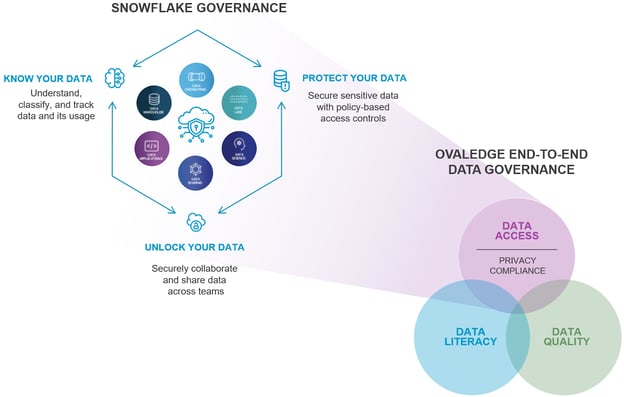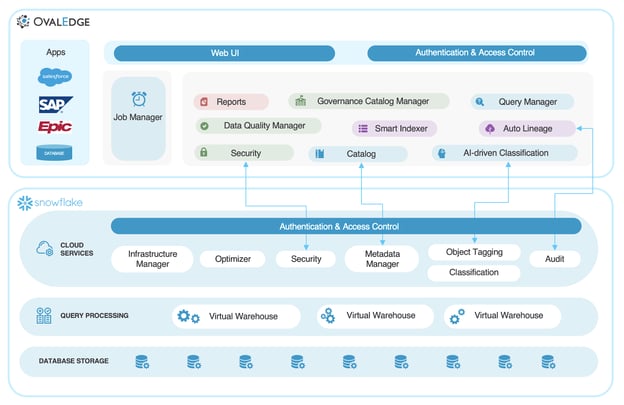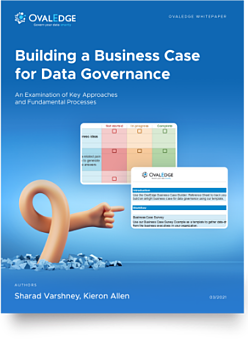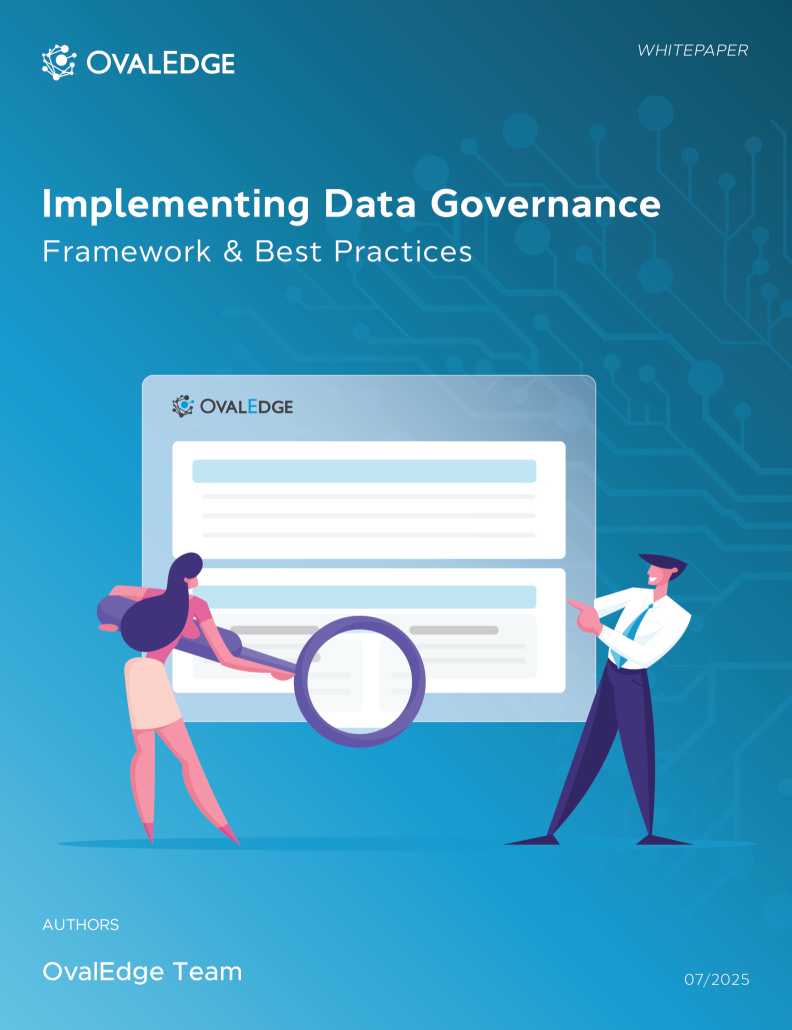Table of Contents
End-to-End Data Governance in Snowflake: Framework, Access & Agility
Data governance is a comprehensive, collaborative process that brings business, compliance, and IT teams together. Collectively, they can ensure data is not only secure but readily available, of high quality, and trustworthy across the multiple applications used by various business units and numerous data platforms.
In light of this growing trend for cross-departmental collaboration on data governance initiatives, two industry leaders, OvalEdge and Snowflake, have entered into an exciting partnership. On the one hand, Snowflake provides a highly scalable platform to bring data from various sources and governance features to ensure that the data is secure and compliant.
This is why the combination of Snowflake and OvalEdge has emerged as a powerful governance ecosystem. Snowflake brings the scalability and built-in governance tools; OvalEdge brings business context, workflow automation, data literacy, quality management, and visibility.
Together, they enable a modern approach to data governance in Snowflake, one that is collaborative, automated, policy-driven, and aligned with real business usage.
On the other hand, OvalEdge connects the dots between application data and data on the Snowflake platform. It ensures data is easily discoverable by business users. It makes data verifiable to promote trust in the system. And introduces various business processes to ensure data access and data quality is maintained across the data ecosystems.
Data in Snowflake must be governed collaboratively
Organizations want to generate the maximum value from their data. However, to do so, they must bring data from various applications like CRM and ERP platforms into one scalable data platform where business users and data teams can query data together to derive the most value.
Snowflake can store almost infinite amounts of data and provide a way to query it, but data must be governed with the same logic used in a CRM or ERP application.
Modern organizations have dozens of applications CRMs, ERPs, HR systems, finance tools, marketing platforms, and more. Each application holds structured business rules, access hierarchies, and domain definitions that business users rely on every day.
When that data enters Snowflake, you cannot lose the meaning and the access logic that governed it in the original application.
For example:
- In the HR app → an employee can see their own salary.
- In Snowflake → they shouldn’t suddenly have access to everyone’s salary.
This is where collaboration becomes critical.
Snowflake access governance isn’t only an IT job.
It requires coordination across:
- Business data owners
- Compliance & security teams
- IT & cloud engineering
- Data stewards
- BI & analytics teams
Together, these teams ensure:
- Policies reflect business roles
- Sensitive data remains protected
- Data is easy to find and understand
- Quality is monitored as data moves
- Compliance frameworks remain intact
This collaborative process lays the foundation for a scalable Snowflake governance framework.
This is why access to data in the Snowflake platform must be governed collaboratively between the business, compliance, and IT representatives responsible for various applications. This type of business process is considered Data Access Governance.
Here is a video on OvalEdge & Snowflake Integration, which walks you through features like masking, tagging, and object history in OvalEdge on Snowflake data.
To implement this kind of governance, it's essential to work with business users, and for that, you must ensure they are data literate. They should have the ability to map their application data, where they generally view data to data in Snowflake, and provide clear and consistent data definitions to make it identifiable. This data governance process is known as Data Literacy.
As data moves from applications into a Snowflake warehouse and delivers value through various use cases, its quality must be tracked and verified. For example, if a CFO reports an organization's numbers to Wall Street, the entire process must be verifiable because the consequences of misreporting are dire. The process of verifying data quality transparently is called Data Quality Management.
Data Access Governance
It's almost impossible to transfer the exact logic from an application into a data warehouse. However, together, Snowflake and OvalEdge provide a comprehensive, easy-to-deploy access governance solution for Snowflake data.

OvalEdge's data protection approach complements the three pillars of Snowflake's data governance strategy: know your data, protect your data, and unlock your data.
Know your data
Before you can govern anything, you must know:
- What data exists
- Where it comes from
- Who owns it
- How it is classified
- What security rules apply
- How it is used across workflows
Snowflake supports tagging, masking policies, lineage, and metadata capture.
But organizations need more.
OvalEdge enhances this pillar through:
- Application-to-Snowflake mapping: Helps business users immediately understand where their application data lives in Snowflake.
- Automated metadata extraction: Every table, column, tag, and transformation is catalogued.
- AI-based data classification: Quickly identifies PII, PHI, PCI, restricted data, etc.
- Synchronization of tags to Snowflake: Ensures consistency across both platforms.
- Glossary and definitions: Reduces confusion and improves cross-team communication.
This unified view drastically reduces the time business users spend finding, validating, and interpreting data, one of the biggest barriers to data-driven decision-making.
At the platform level, Snowflake provides users with a way to tag data. However, OvalEdge delivers a comprehensive UI to map business applications to Snowflake data so both business and technical users can understand its metadata.
Furthermore, OvalEdge provides business processes and AI to classify the data for security and compliance reasons, enabling an organization to classify all its data within weeks.
OvalEdge also supports a native integration to share these tags with Snowflake. Once you identify and classify the data, it will be tagged in Snowflake automatically. This process provides a way for Snowflake users to understand data assets easily.
Protect your data
Once classified, Snowflake must protect data based on its classification and security policies. Organizations can configure these policies either in OvalEdge or Snowflake. Once configured, OvalEdge uses Snowflake APIs to protect the data in Snowflake.
Once data is identified and classified, organizations must enforce consistent protection policies.
Snowflake provides:
- Row Access Policies
- Dynamic Data Masking
- External Tokenization
But the real complexity lies in:
- Who approves access?
- How does a policy change propagate?
- How do you ensure policies align with business roles?
- How do you enforce policy versions across domains?
OvalEdge simplifies this by:
- Managing governance workflows
- Documenting approvals in audit logs
- Automating policy pushdown using Snowflake APIs
- Mapping access rules to business-friendly language
- Ensuring policies are enforced consistently
This transforms governance from a scattered, manual effort into a repeatable, transparent, and audit-friendly process.
This phase is also the integration point. While Snowflake provides column-level masking and row-level security, data management takes place in OvalEdge through its graphical user interface (GUI) and various business processes.
For example, Snowflake may flag up that a user has specific permissions in their role. However, without a business process that determines who gives these permissions, governance is problematic. OvalEdge takes care of this through various policies, which are automatically transferred through Snowflake's policy access management and security features so users can view the governed data in Snowflake.
Related: Data Security in Snowflake Via OvalEdge
Unlock your data
Snowflake provides the technical capabilities to unlock data and make it available to users when it's required. However, this access is determined by well-defined rules and policies, and although this enables automation, there is no room for Ad Hoc access permissions. This is where OvalEdge comes in because these processes can be completed quickly and on an Ad Hoc basis.
Even the best policies can create bottlenecks when users need temporary or exception-based access.
Snowflake’s secure architecture ensures data is locked down appropriately but exceptions, project-based needs, and time-bound access still need a business-approved process.
OvalEdge enables:
- Ad-hoc access requests
- Temporary permission windows
- Approval routing to business data owners
- Visibility into who has access and why
- Automated expiration of temporary access
Example:
An HR analyst needs full employee compensation data for a one-week project.
Instead of waiting days for IT to intervene:
- They request access via OvalEdge
- The HR manager approves
- Snowflake applies the access policy
- Access auto-revokes after one week
This reduces friction, speeds up analytics, and ensures compliance is never broken.
OvalEdge also unlocks data in other ways through its easy-to-use GUI. In this space, users can share and collaborate on data assets seamlessly.

Data Literacy and Data Quality Management
Along with Data Access Governance, OvalEdge supports a comprehensive Data Literacy program. The OvalEdge data catalog can crawl all of a Snowflake user's data, categorize, and tag it to make it discoverable.
When users can find data easily, data literacy increases over time. OvalEdge enables this simple data discovery and, crucially, collaboration on data assets.
Data Literacy
Being able to “use data” is not the same as “understanding data.”
OvalEdge boosts literacy by giving users:
- A Google-like search experience
- Business glossary definitions
- Dataset descriptions & context
- Tags that tell users sensitivity levels
- Ownership details
- Clear lineage from source → transformation → consumption
This helps non-technical users confidently navigate Snowflake, request access, and collaborate.
Data Quality
Bad data destroys trust, slows teams down, and leads to poor decisions.
OvalEdge supports:
- Data quality rules
- Scorecards
- Exceptions & issue tracking
- Alerts
- Automated checks powered by Snowflake compute
This ensures that as data moves from applications → pipelines → Snowflake → dashboards → decisions, its quality remains visible at every step.
When teams trust the data, they use the data, and this is what fuels business agility.
The OvalEdge Data Quality Management program focuses on the lifecycle of data, ensuring its trustworthiness. Snowflake customers can leverage these data quality improvement capabilities using Snowflake's processing power.
When users trust data, they are more likely to use it to make business decisions. These data-driven decisions are critical for growth in a competitive marketplace.
The Perfect Team
Organizations choose Snowflake because it offers:
- Extreme scalability
- Low-latency queries
- Zero-maintenance infrastructure
- Fine-grained security controls
- Seamless data sharing
Organizations choose OvalEdge because it enables:
- Business-driven governance
- Cataloging, tagging & glossary
- Access management workflows
- Quality monitoring
- Lineage & impact analysis
- Collaborative data usage
Together, they deliver the blueprint for:
✔ A complete Snowflake data governance program
✔ A modern Snowflake governance framework
✔ Enterprise-grade Snowflake access governance
✔ Higher adoption, trust & agility across teams
This partnership ensures that Snowflake becomes not just a powerful data warehouse but a fully governed, secure, business-aligned data platform.
Together, OvalEdge and Snowflake can deliver a complete solution for data warehousing and progressive data governance.
FAQs
1. What is data governance in Snowflake?
Data governance in Snowflake refers to the frameworks, policies, workflows, and controls organizations use to manage data accessibility, security, quality, and compliance within the Snowflake Data Cloud.
2. How does OvalEdge enhance Snowflake governance?
OvalEdge expands Snowflake’s capabilities by adding cataloging, metadata mapping, automated classification, workflow automation, data quality monitoring, and business-friendly interfaces that make governance collaborative and scalable.
3. What is Snowflake access governance?
It is the process of defining, controlling, and auditing who can access which Snowflake data assets based on roles, sensitivity classifications, compliance needs, and business approvals.
4. Can OvalEdge automate tagging and classification of Snowflake data?
Yes. OvalEdge automatically discovers Snowflake metadata, applies AI-based tagging, maps business glossary terms, and syncs classifications back to Snowflake tags.
5. Does Snowflake support end-to-end governance?
Yes. Snowflake provides strong governance primitives, and platforms like OvalEdge build the business layer on top of them, creating a complete, end-to-end governance ecosystem.
What you should do now
|
OvalEdge recognized as a leader in data governance solutions
.png?width=1081&height=173&name=Forrester%201%20(1).png)
“Reference customers have repeatedly mentioned the great customer service they receive along with the support for their custom requirements, facilitating time to value. OvalEdge fits well with organizations prioritizing business user empowerment within their data governance strategy.”
.png?width=1081&height=241&name=KC%20-%20Logo%201%20(1).png)
“Reference customers have repeatedly mentioned the great customer service they receive along with the support for their custom requirements, facilitating time to value. OvalEdge fits well with organizations prioritizing business user empowerment within their data governance strategy.”
Gartner, Magic Quadrant for Data and Analytics Governance Platforms, January 2025
Gartner does not endorse any vendor, product or service depicted in its research publications, and does not advise technology users to select only those vendors with the highest ratings or other designation. Gartner research publications consist of the opinions of Gartner’s research organization and should not be construed as statements of fact. Gartner disclaims all warranties, expressed or implied, with respect to this research, including any warranties of merchantability or fitness for a particular purpose.
GARTNER and MAGIC QUADRANT are registered trademarks of Gartner, Inc. and/or its affiliates in the U.S. and internationally and are used herein with permission. All rights reserved.



.webp)


